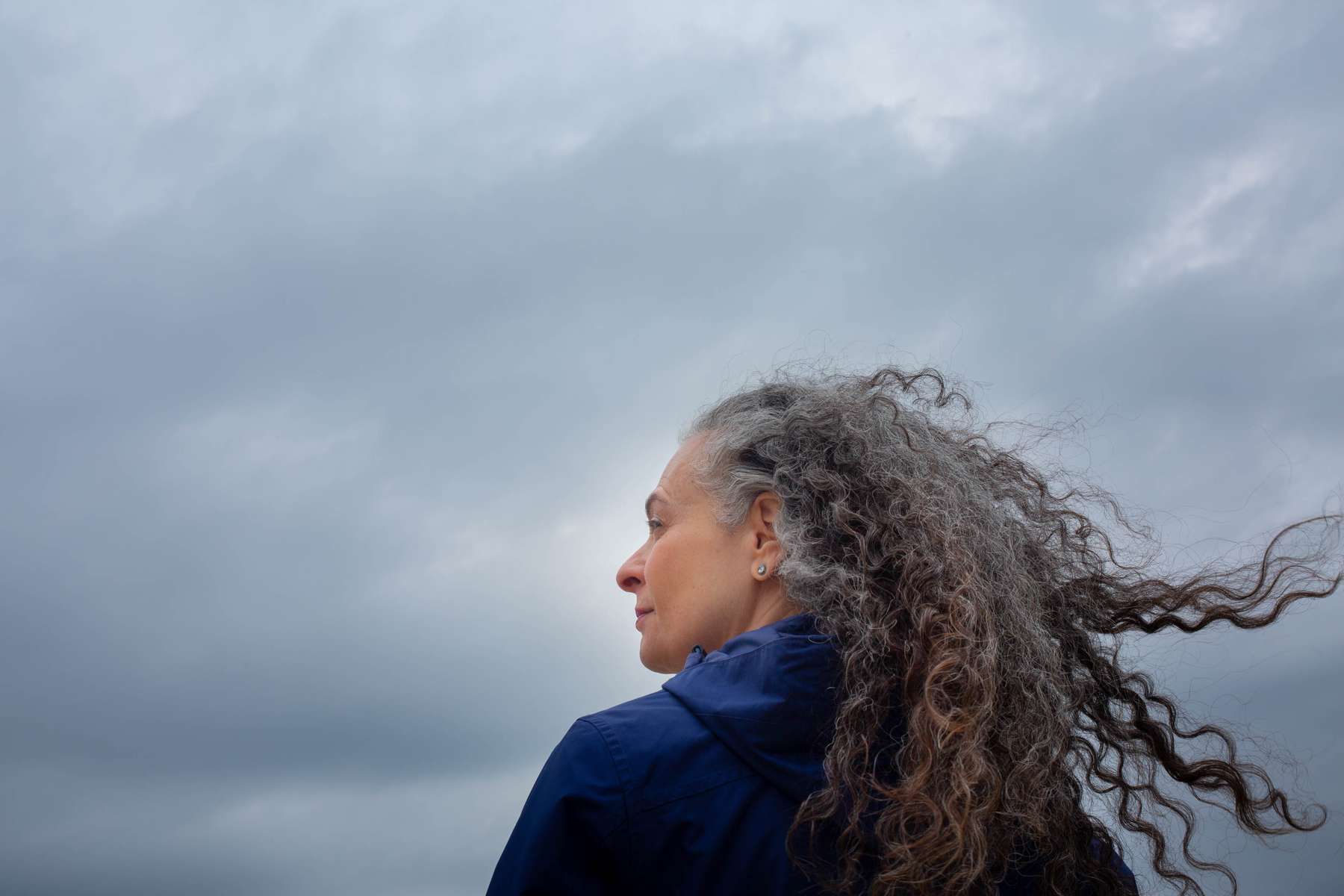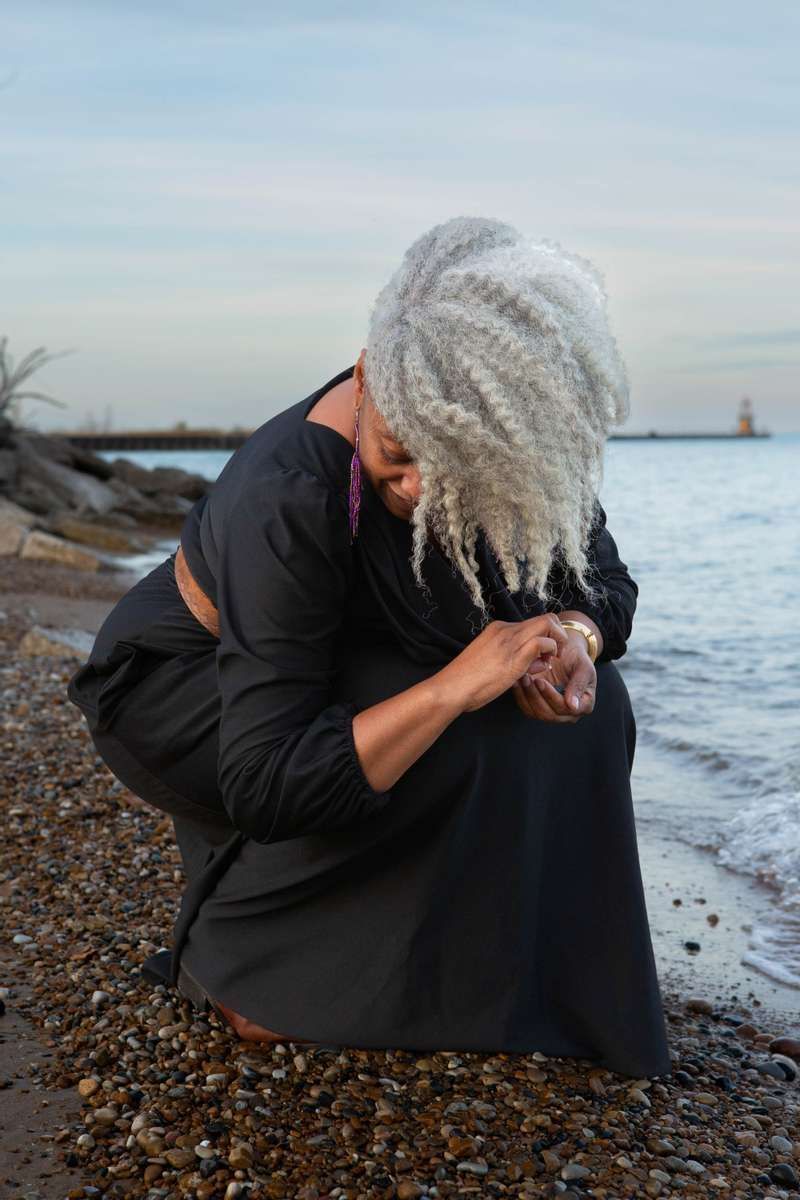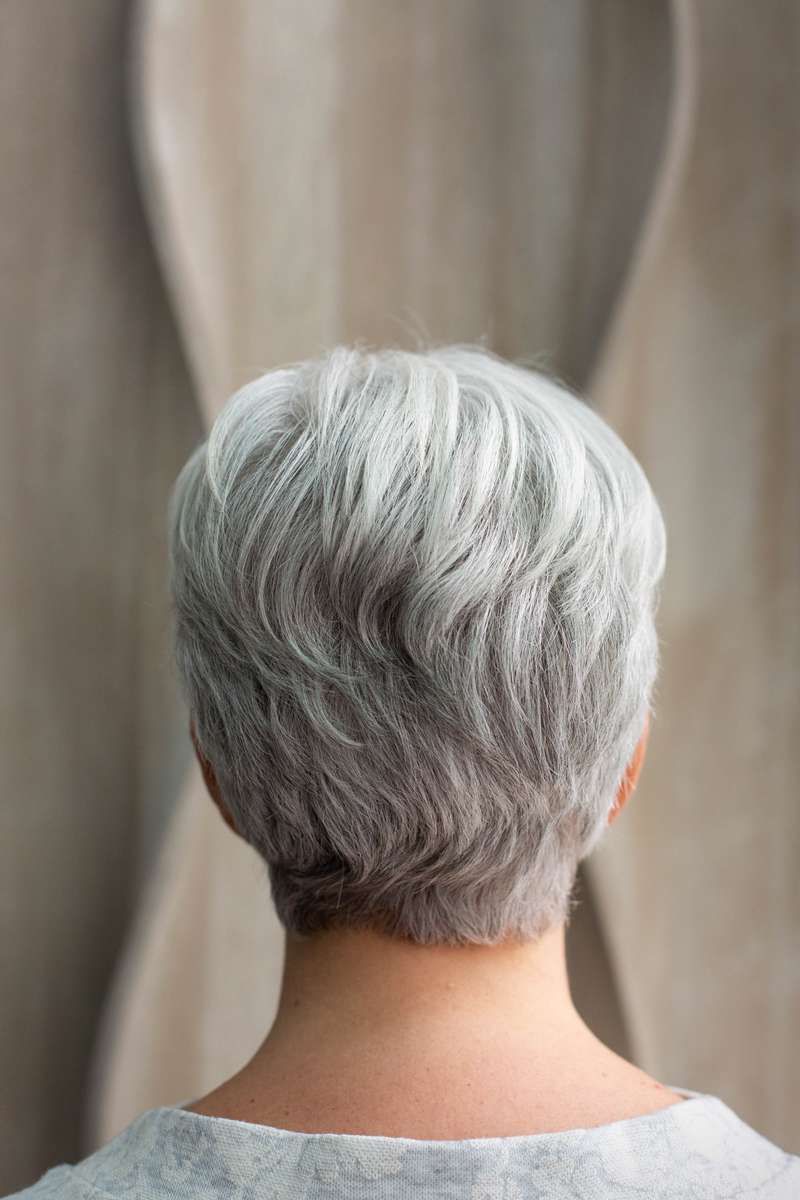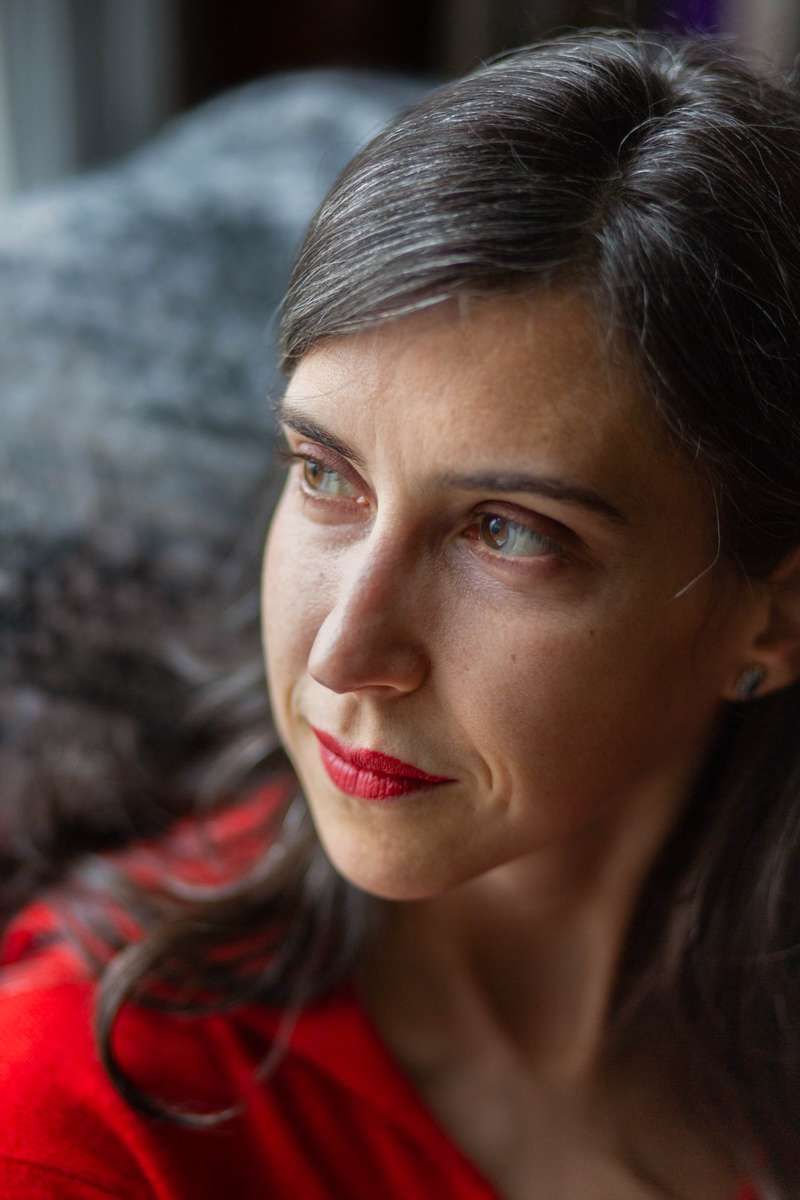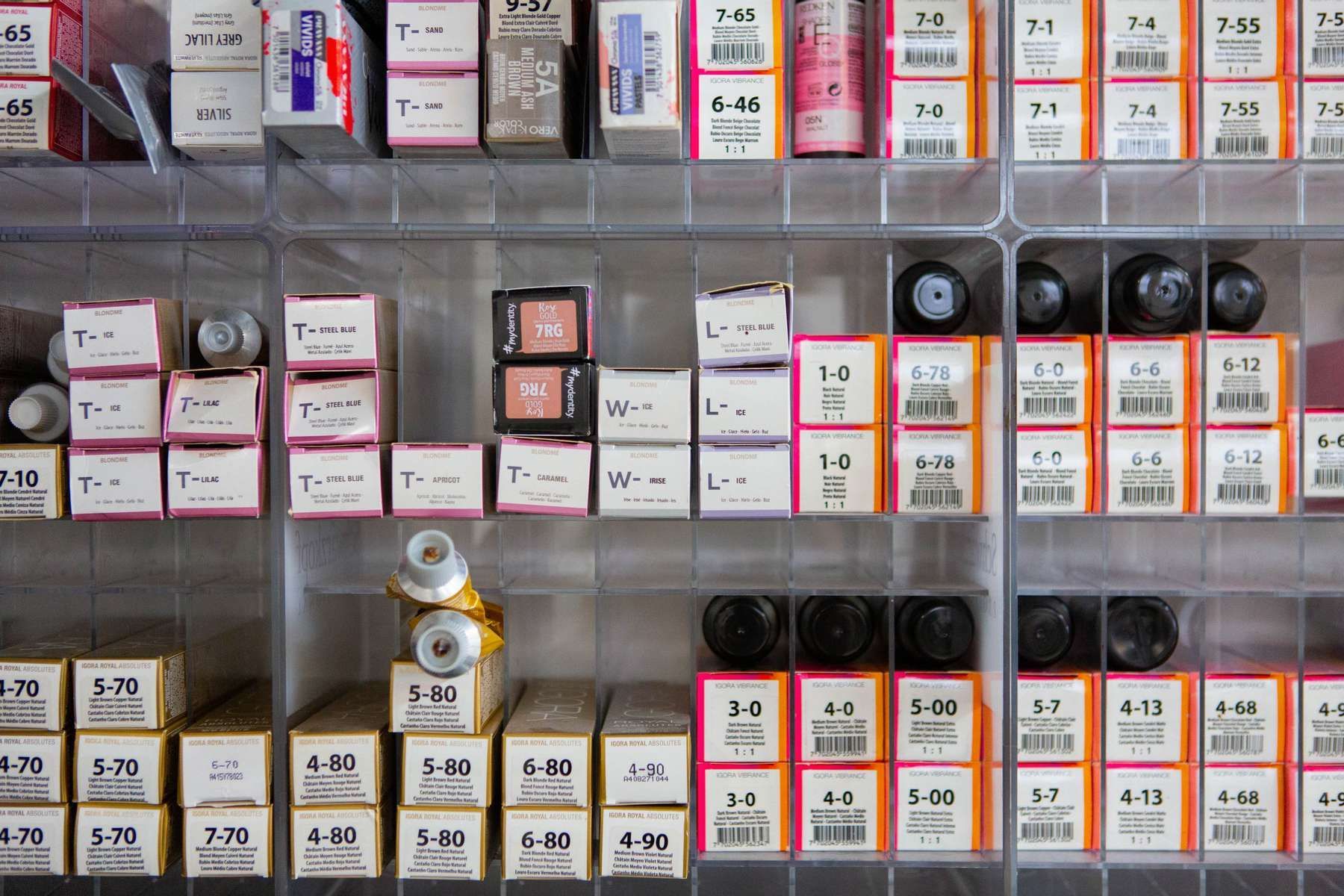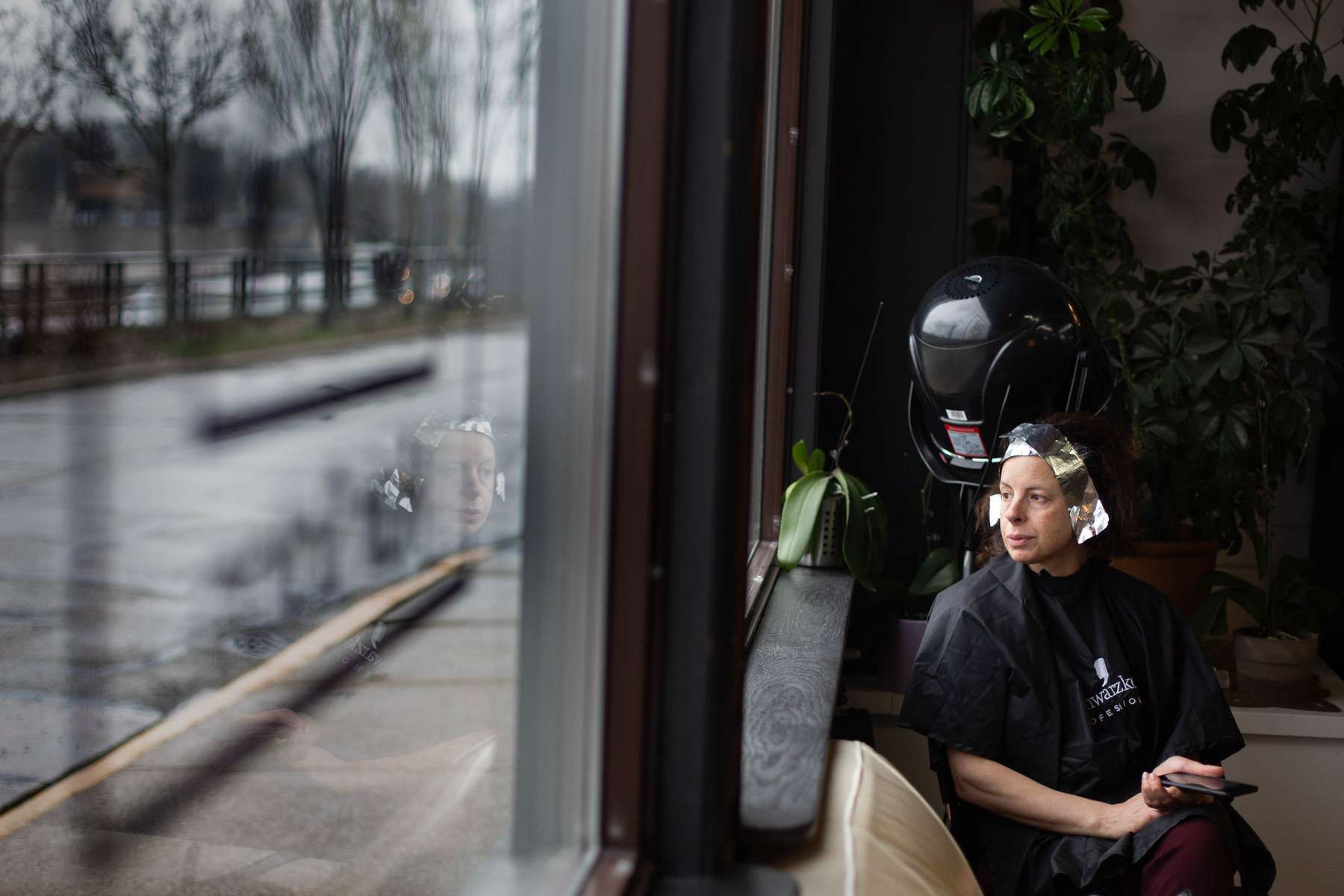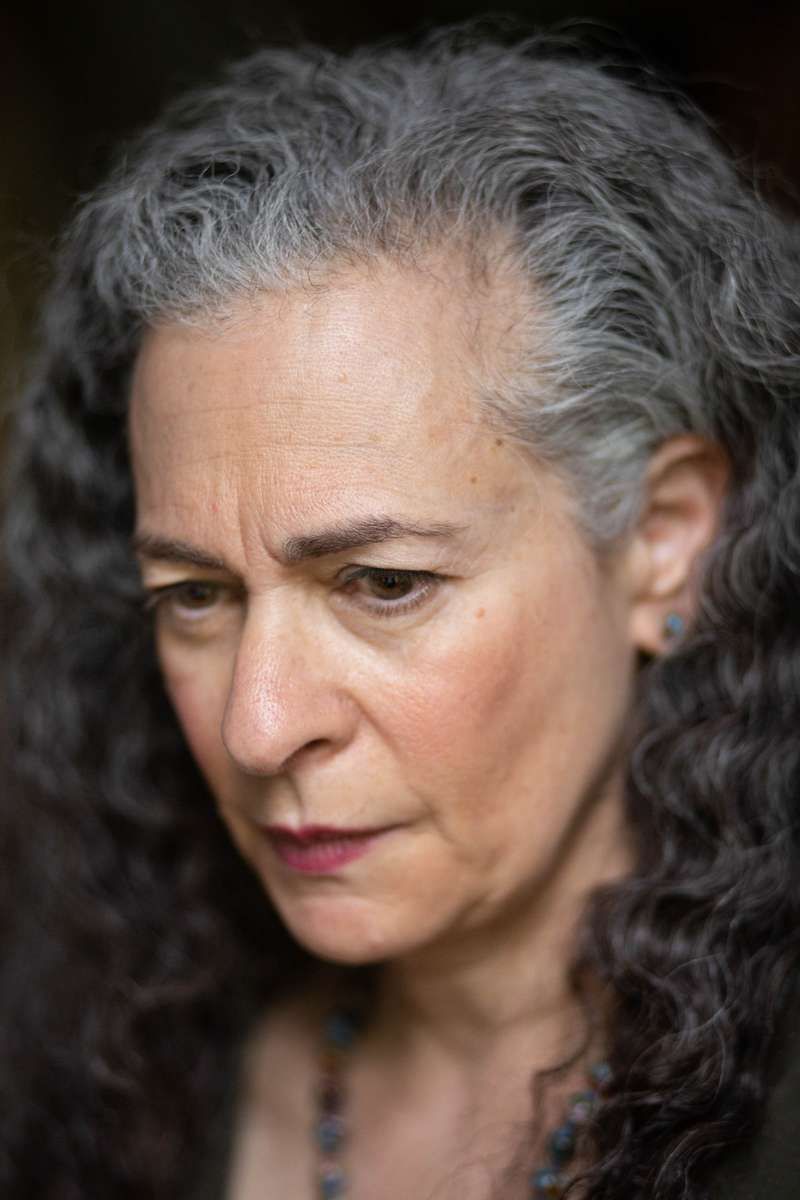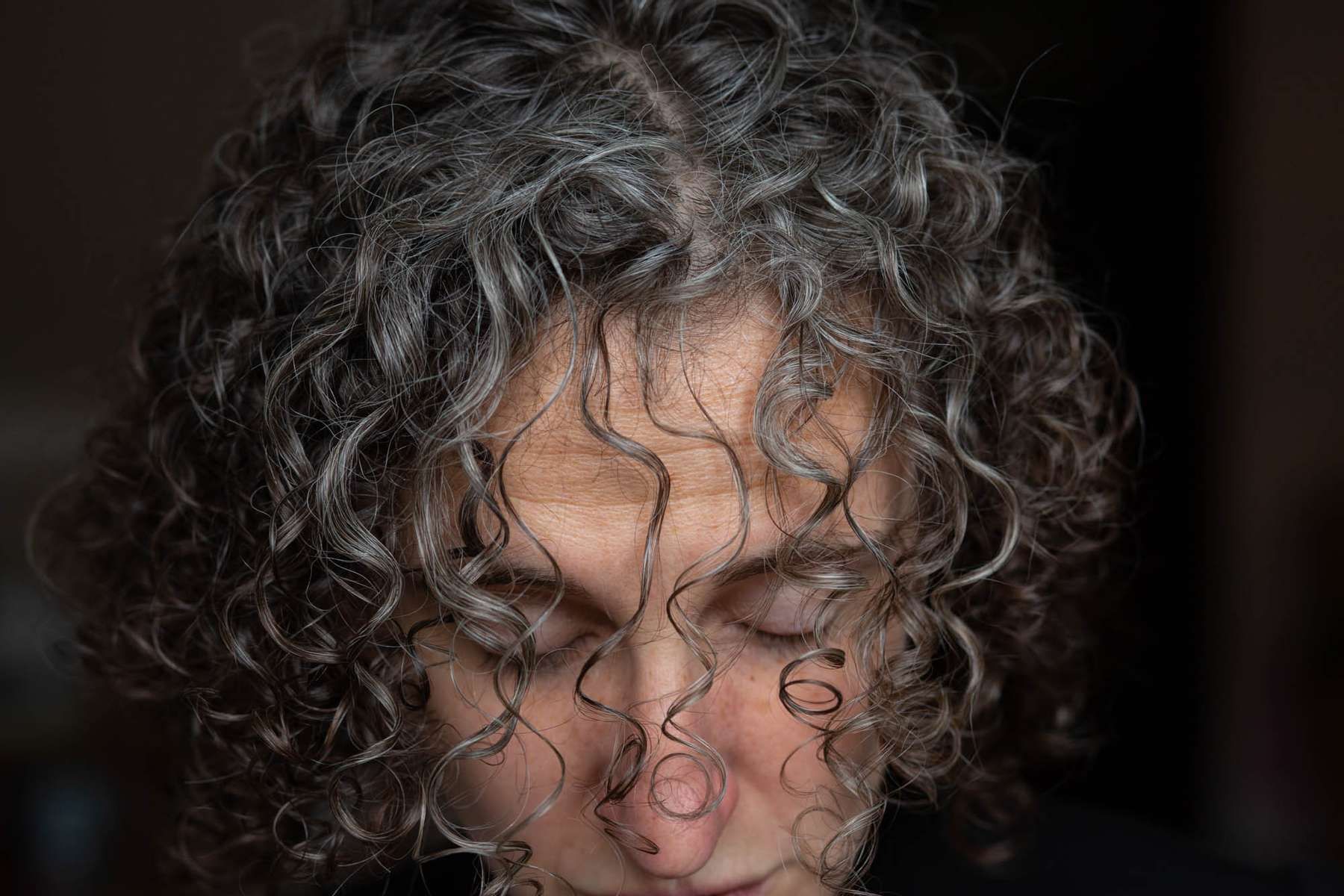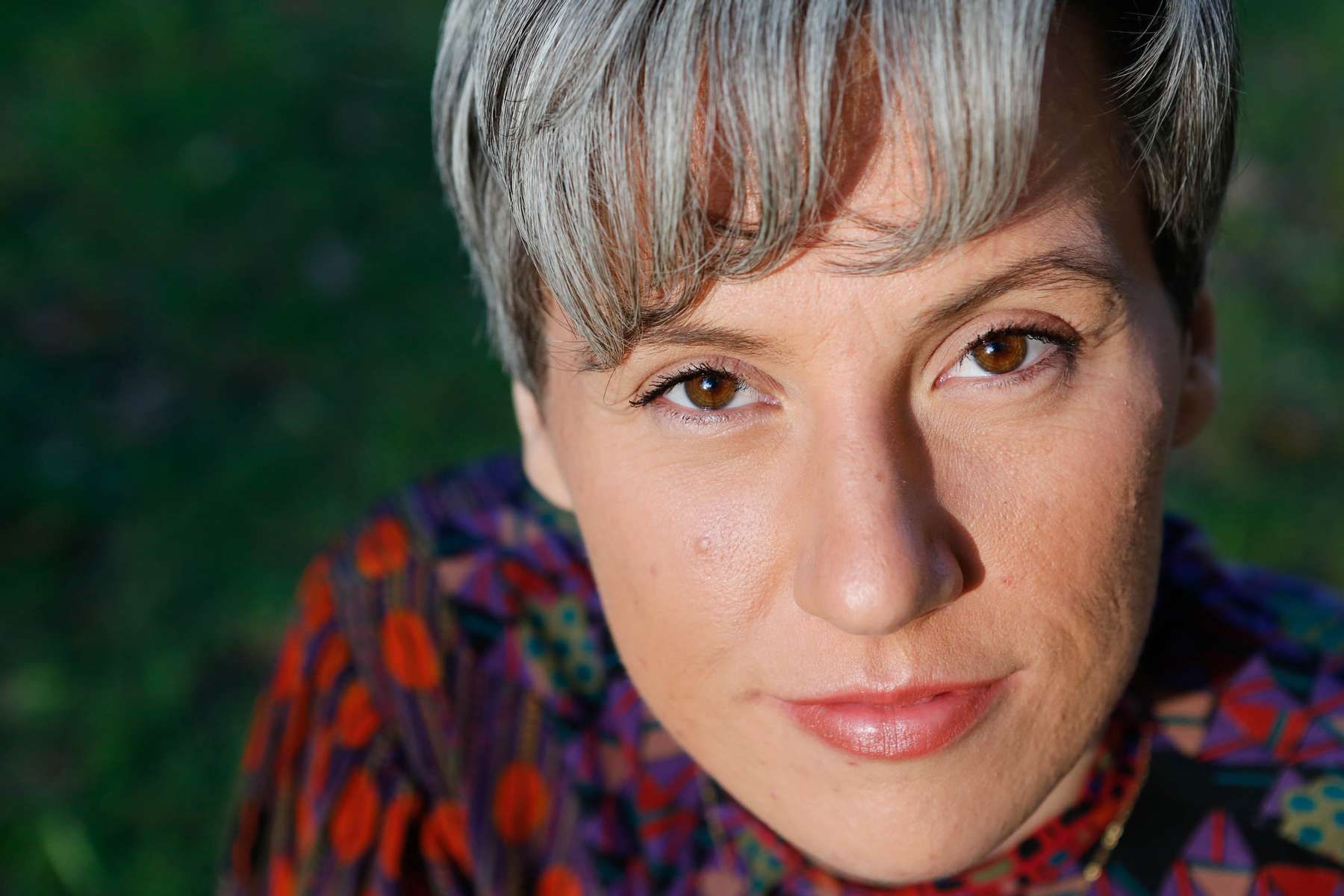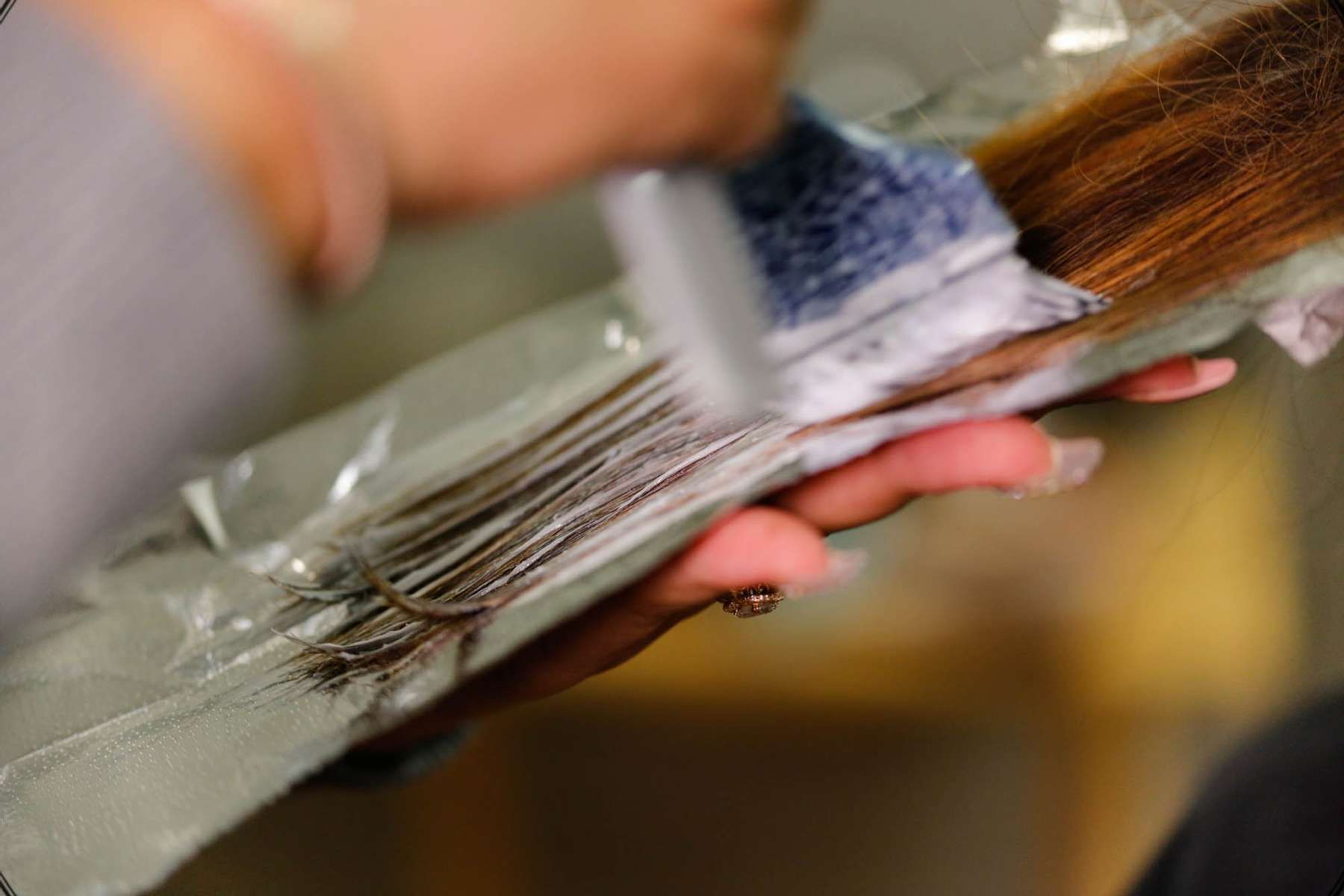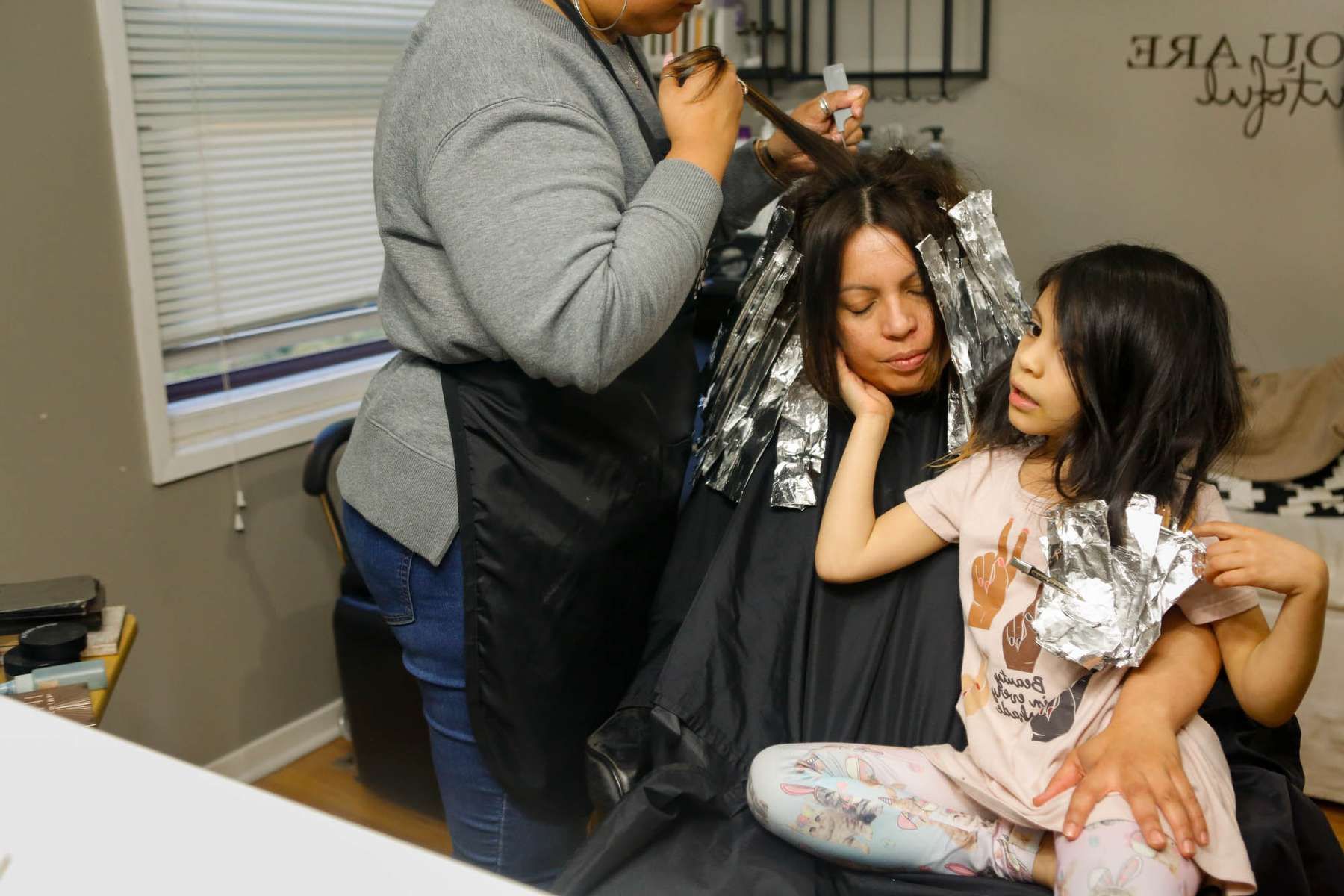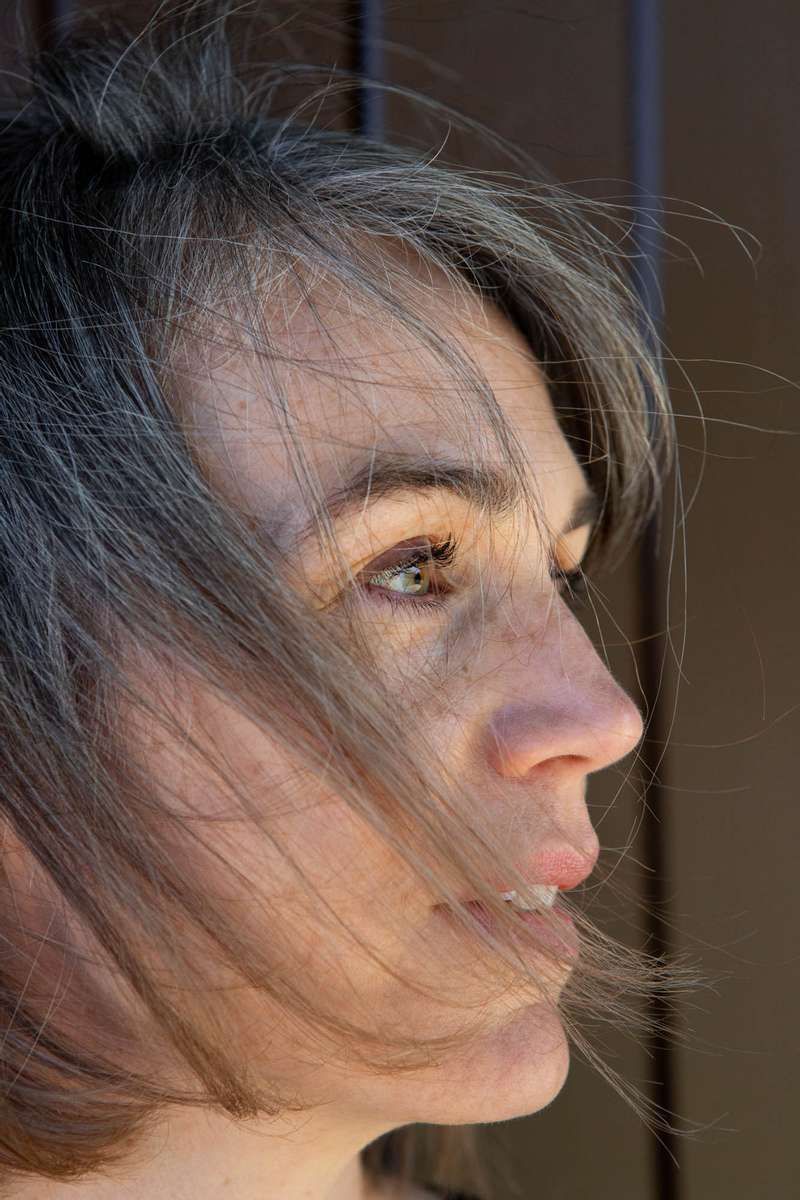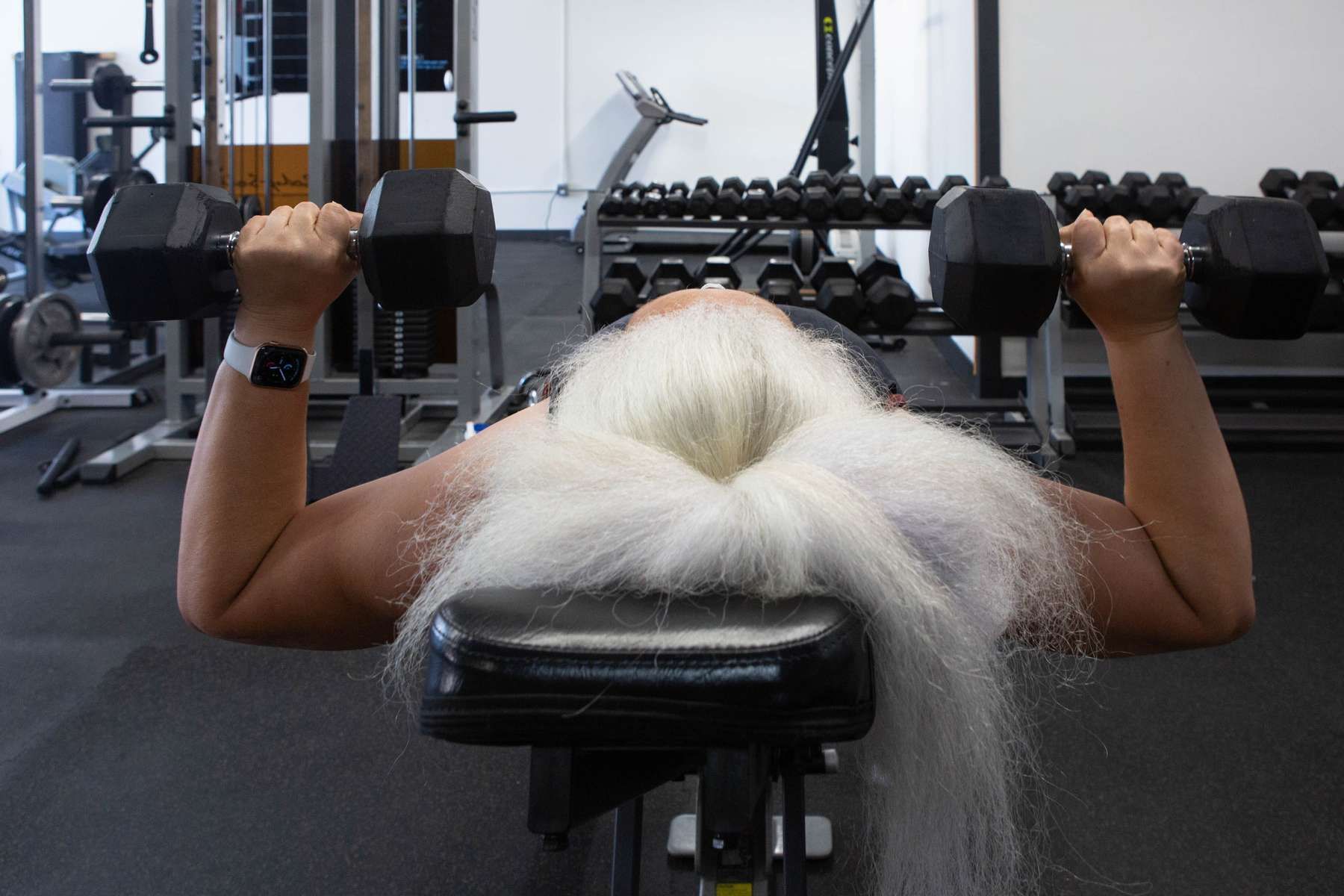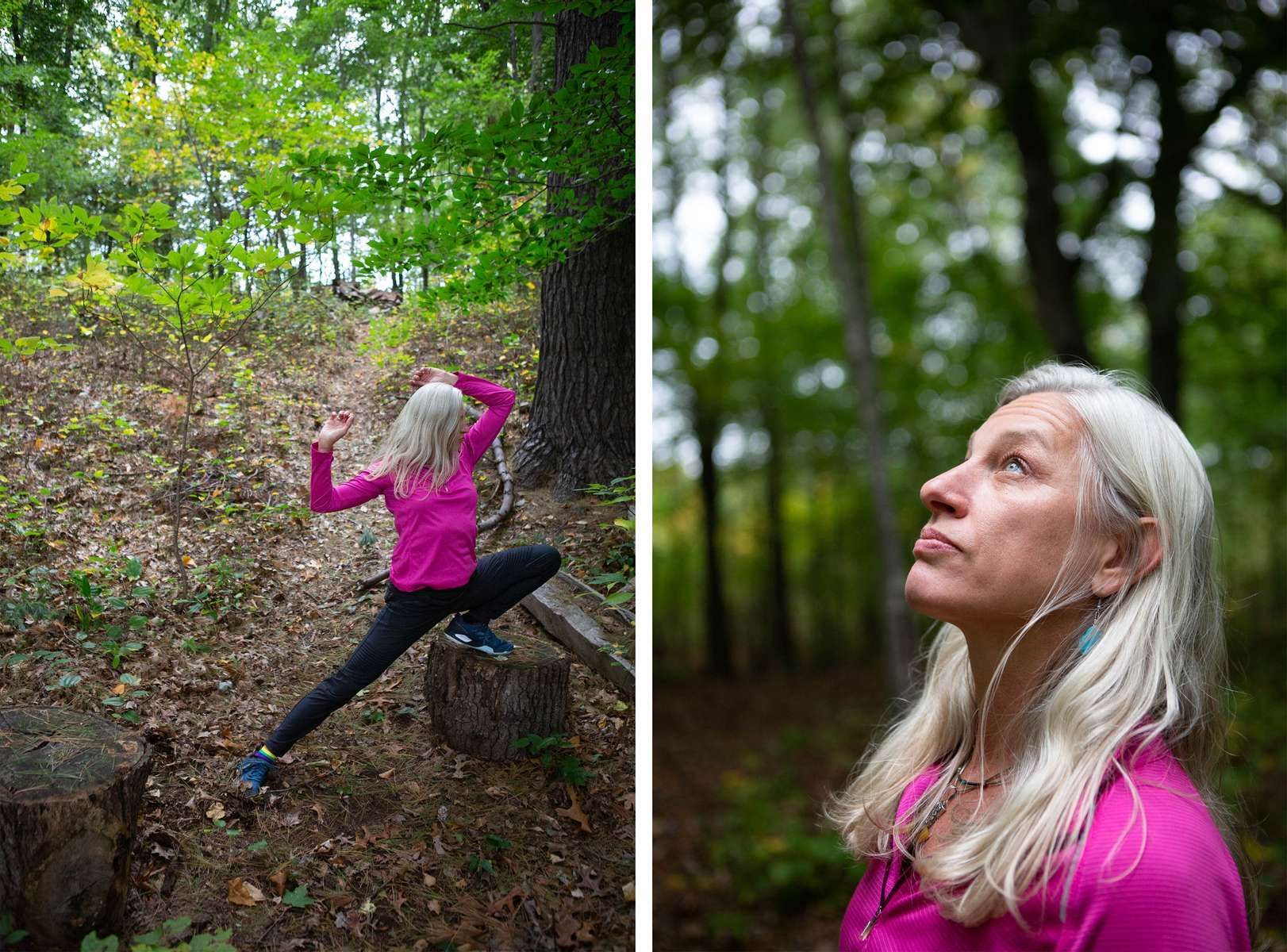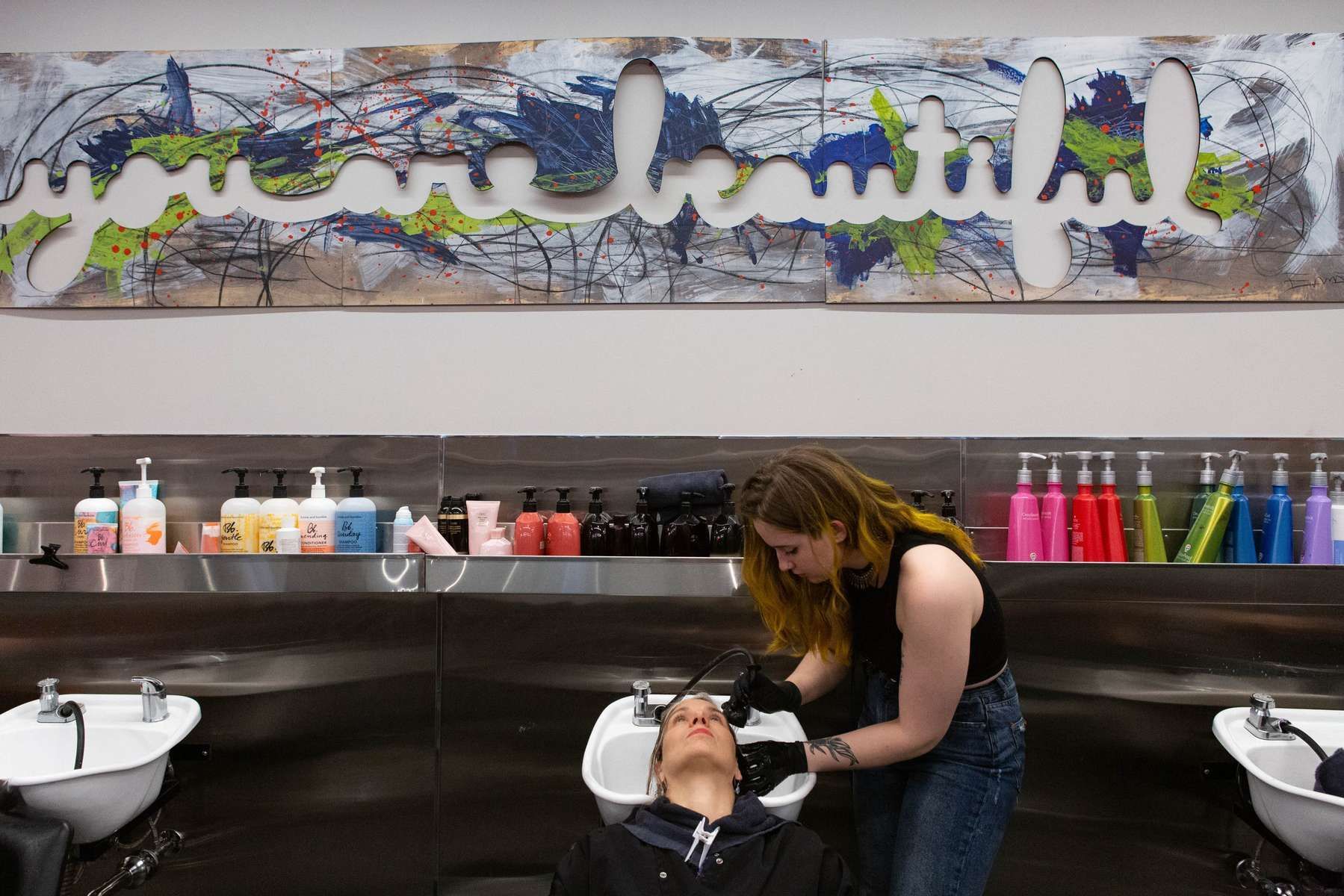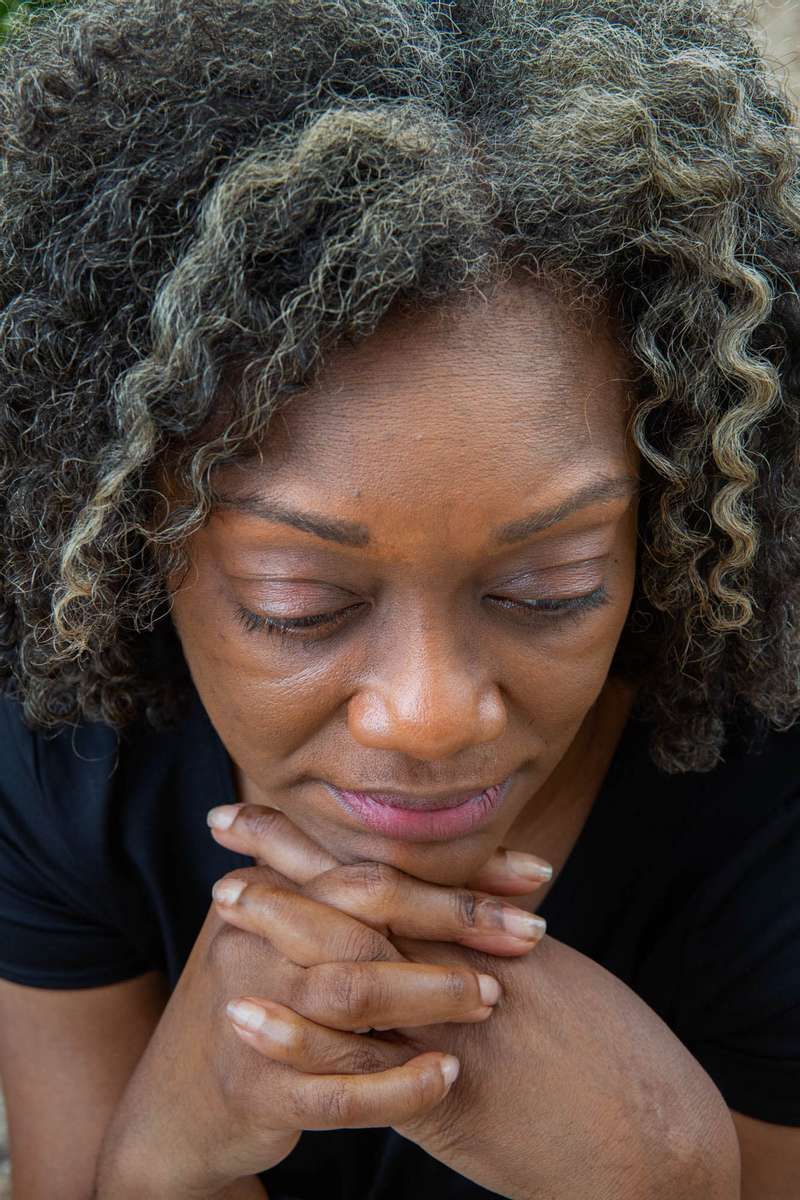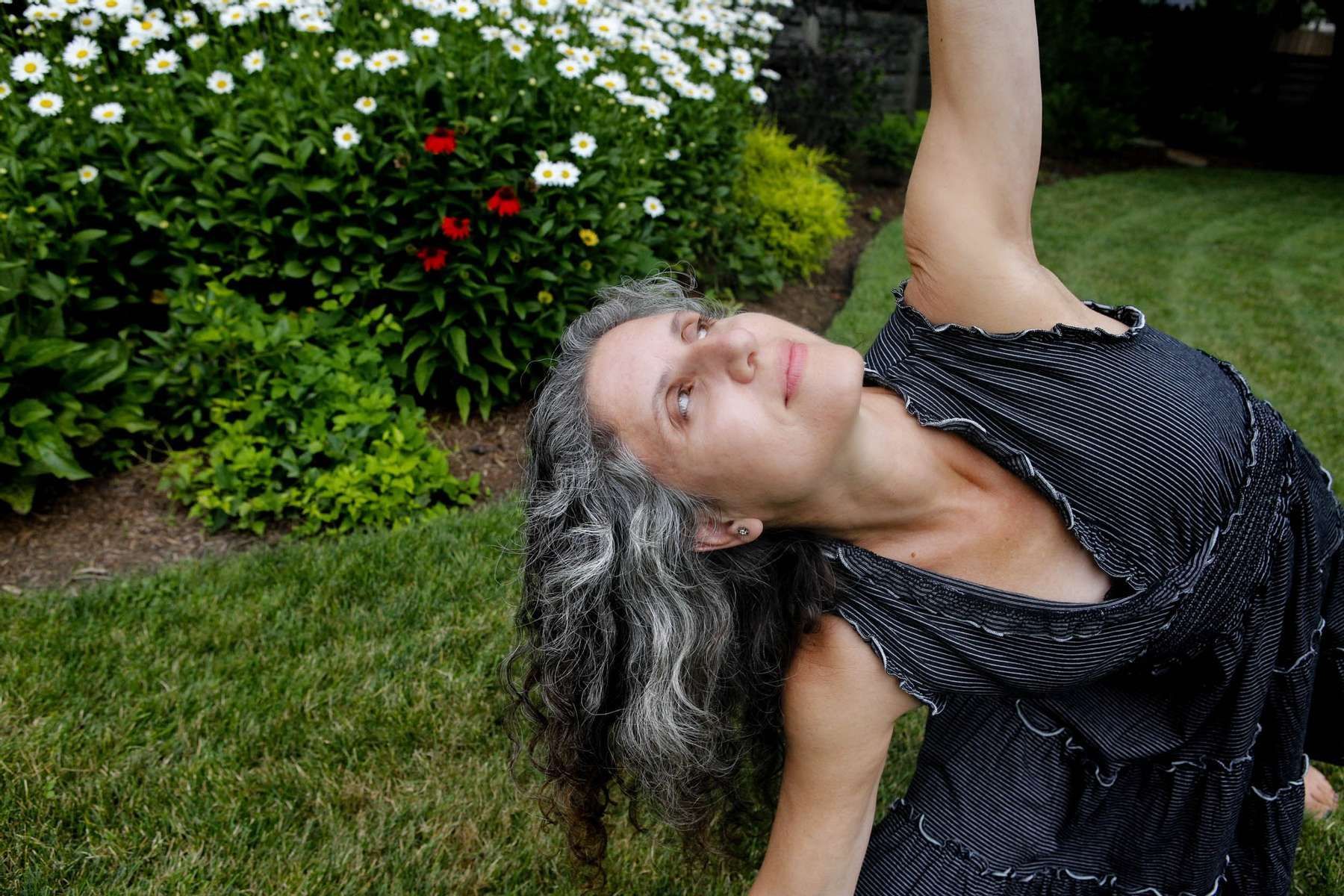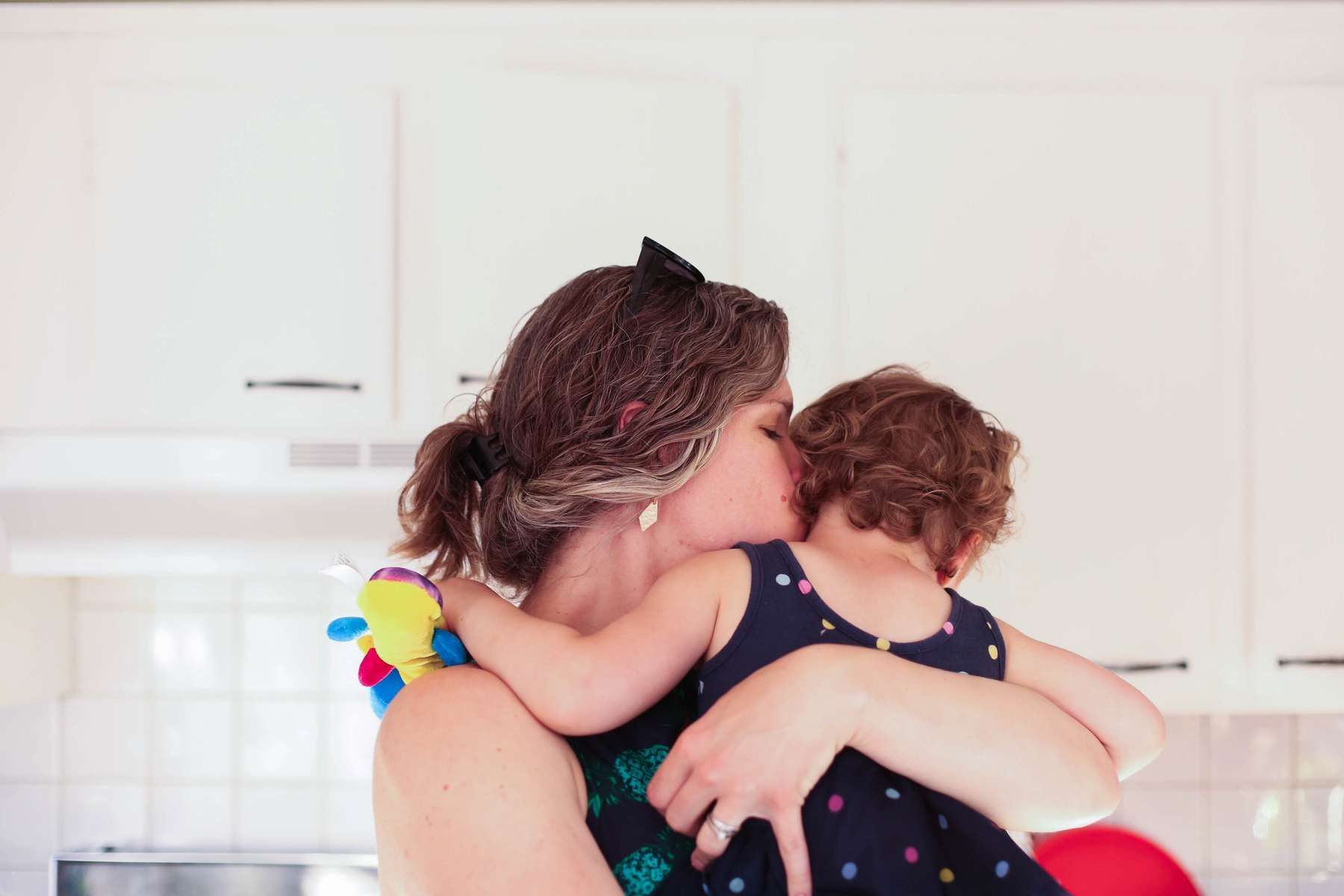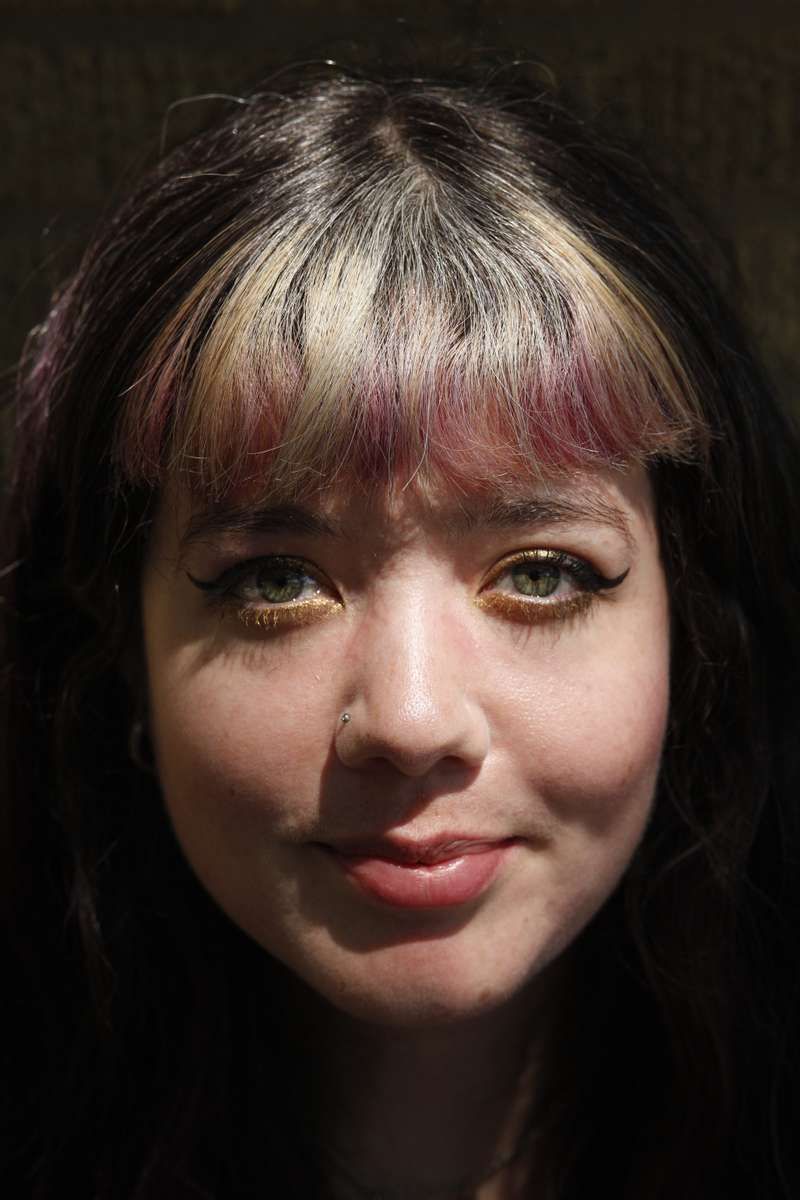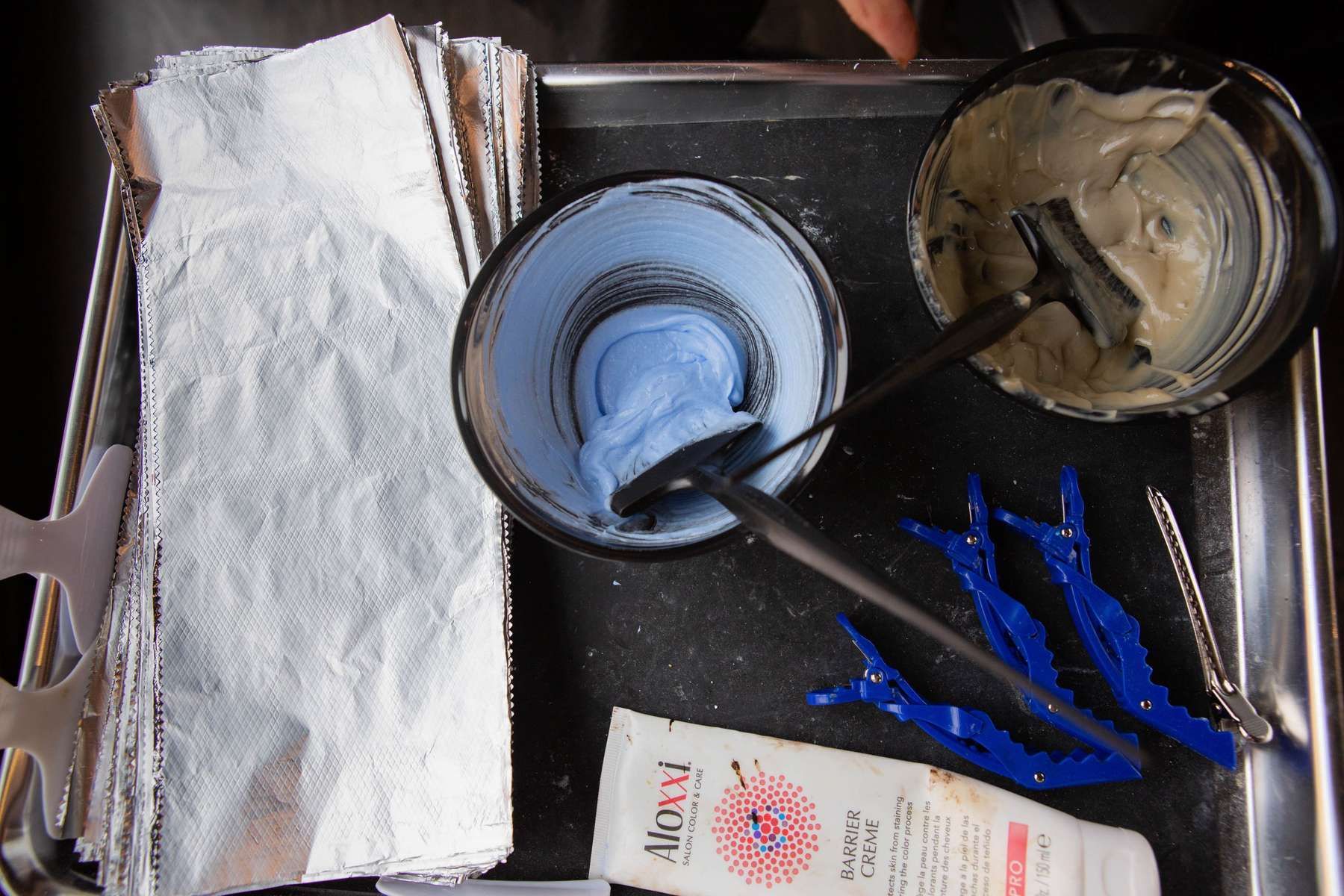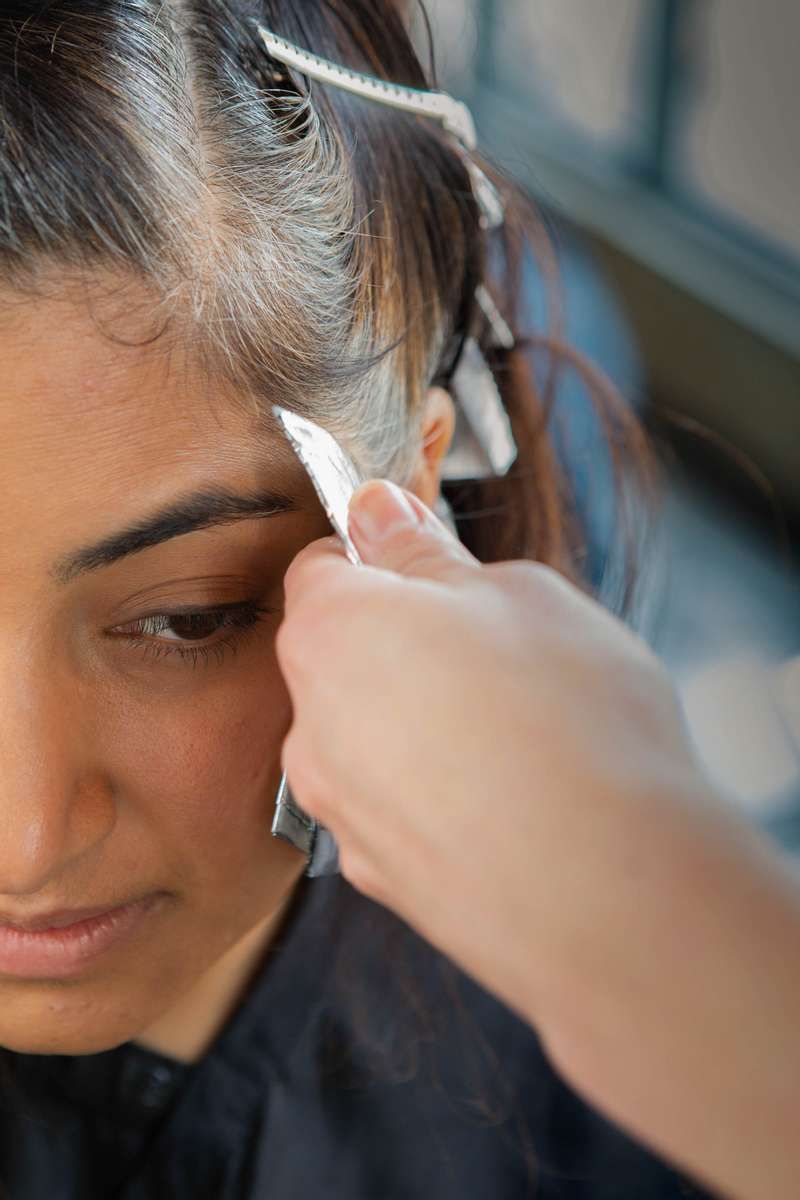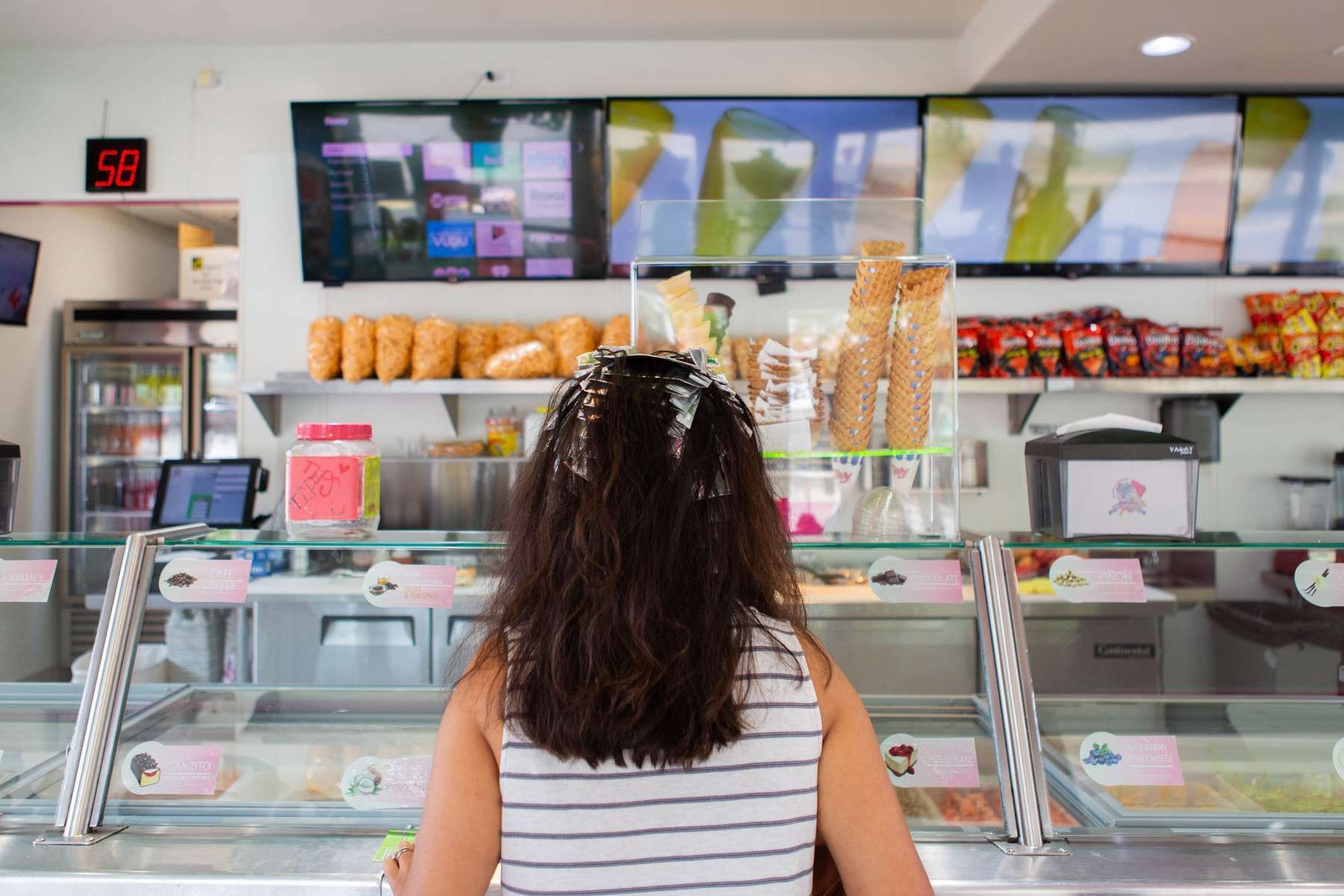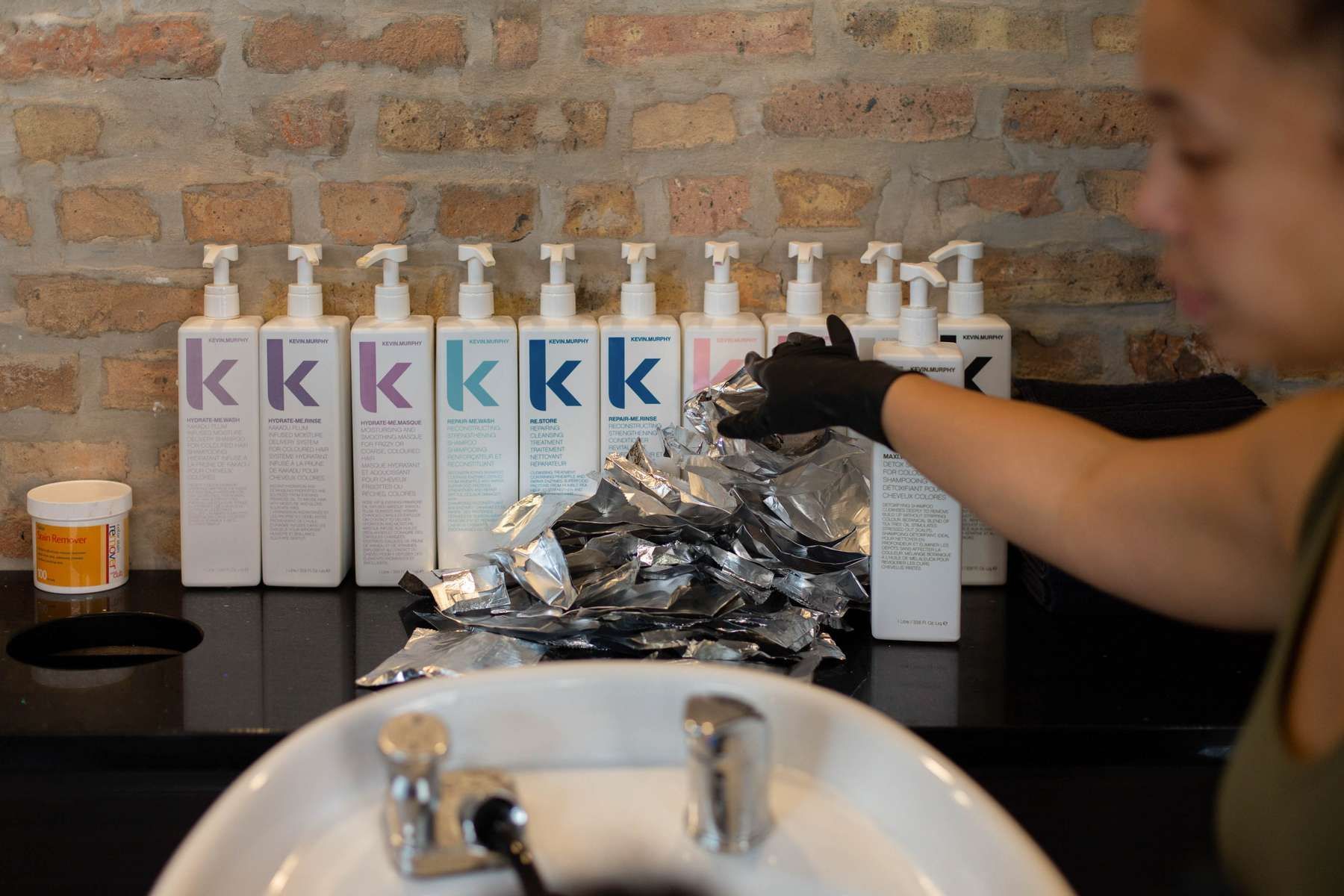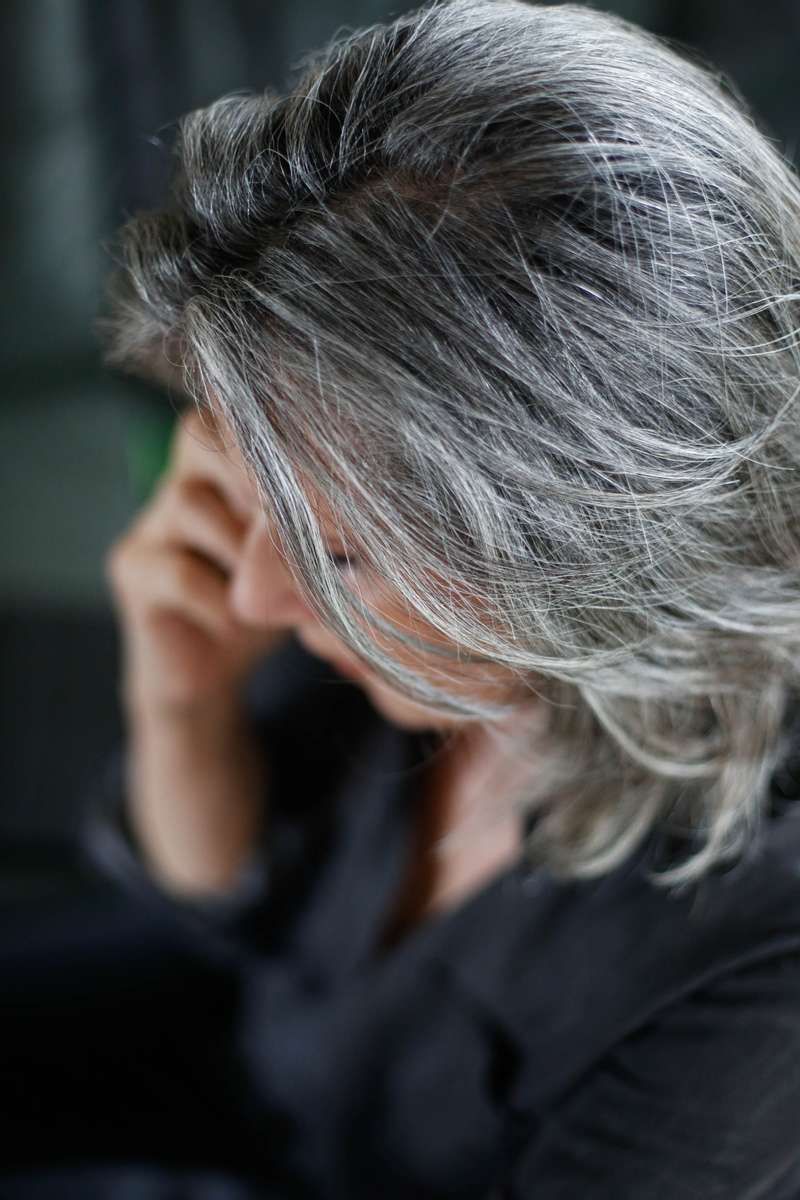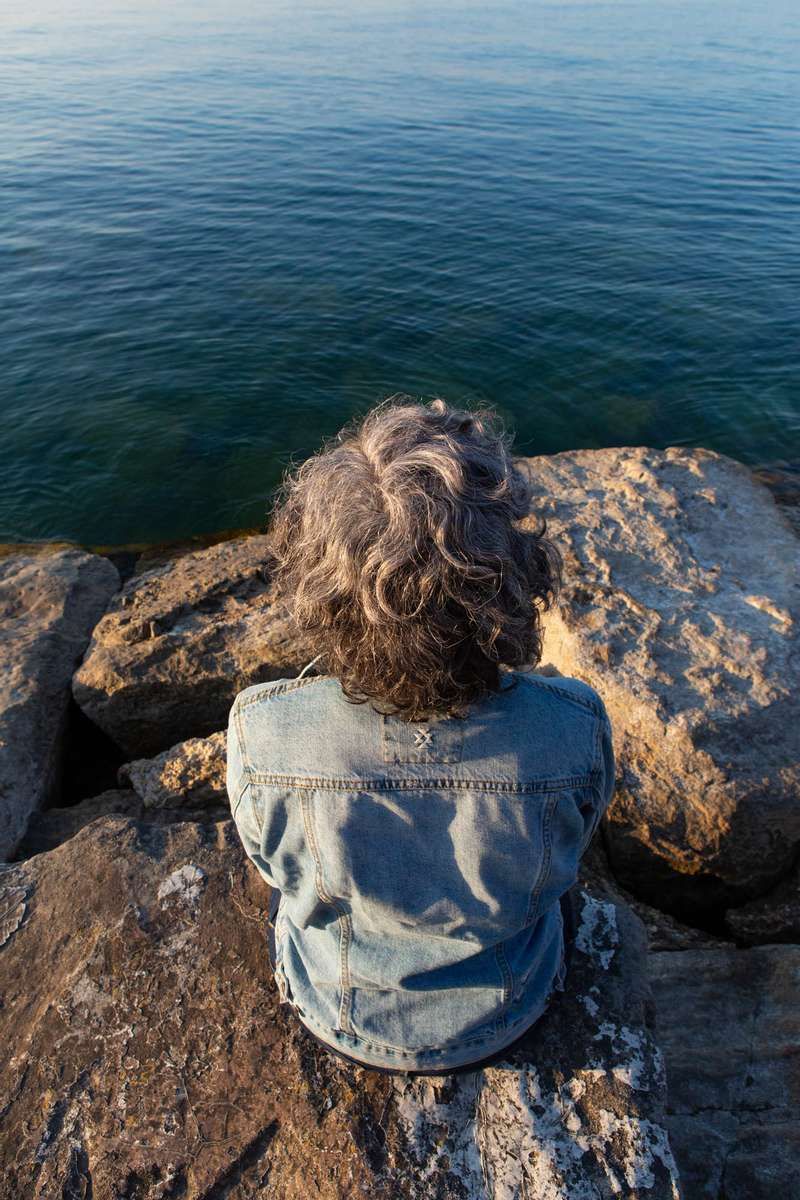GRAY
United States, 2019-present
“Mommy, your hair is getting gray! Are you going to die?” This was my then 7-year-old daughter’s reaction to my increasingly gray hair at age 35. It was heart-wrenching. I replied, “Yes, eventually, but not because I stopped dyeing my hair. Coloring my hair will not keep me from dying.”
After my daughter pointed out my grays (and my mortality) our exchange became a bigger thought, that death—divorce, aging, leaving a job because of discrimination—can be rebirth for women. Are we now looking at the death of dying our hair to fit traditional beauty standards?
After talking with Rosie, I stopped “dying” and started asking, “Why am I the only one with gray?” Then came the #MeToo movement and more women chose to stop coloring their hair. This was followed by the pandemic that cut off so many from their colorists. Would they dye their hair at home or quit? Simple questions about my own hair became a larger conversation about male gaze, ageism, and how women build their sense of selves—it became GRAY.
Now, there are more stories across different platforms about women redefining beauty and power through the simple act of “going gray.” From Andie McDowell to Paulina Porizkova, Rep. Katherine Clark to Tracee Ellis Ross, women are talking about gray hair and its impact on relevance and hireability. Hundreds of women dedicate their Instagram feeds to going gray. More corporations are embracing models with gray hair. While this is progress, ageism in the office still exists and starts at 40 for women, but 45 for men. In one study, women were almost twice as likely to feel the need to dye their hair to combat ageism at work. This is a zeitgeist moment for this subject.
GRAY explores what a woman's personal choices about her hair mean in the context of self, family, friends, co-workers, lovers, and partners. In GRAY, I focus on women at all stages of life, variously accepting or defying the identity imposed by age and hair color. Through collaboration with a diverse range of women, GRAY explores what motivates individuals either to dye their hair or to "let it go."
These portraits, and the interviews that accompany them, expanded my understanding of this complicated choice. Like many internal debates, the questions we ask ourselves reflect a wider societal dialogue about our appearance, our worth, and our place in the world.
This is an ongoing portrait series. If you’re interested in being interviewed and photographed for this project please email: beth.rooney@gmail.com
Gail Siegel, Retired Policy Director for the Cook County Clerk’s Office, 64.
“I know it (going gray) bothered other people more than me. I was uncomfortable when they decided it was up for discussion and to give me unsolicited input. Still, there’s pleasure in the transition: from golden toddler locks, to brownish childhood mop, to dark adult curls, to silvery streaks.
I’m always surprised and delighted when someone admires my hair. I used to get a lot of attention for my hair and I forget that feeling. It’s always nice to experience it again. I have been gratified when friends have decided, after looking at my hair, that they are going to stop coloring theirs. It’s happened several times. They ALWAYS look better.”
Sekile Nzinga, Chief Equity Officer at Office of the Governor Illinois, 50.
“I wore my hair natural since 1993, but I had been coloring it since 2005 when it turned almost completely white. I eventually started to question why I was dyeing my hair when I had stopped using all other chemicals in my hair years earlier. I wondered about all the health implications of the dyes and wondered why I wasn’t just embracing my own naturally white hair color. In 2017 I finally decided, ‘this is not me’ but decided not to do a dramatic “big chop” but go the “skunk” route. I lived with a hard line of natural white and dark dyed hair for over a year! I then went to a stylist on my 47th birthday and she cut it into a shoulder length bob, cutting almost all the dyed hair out. I was scared at first, but it felt good—I felt surprisingly like myself.
This life change came around the same time I came out as queer, so I jokingly say 2017 was the year I went “gay and gray”! For me, my gray hair, my coming out, my self-acceptance—I was uncovering the last bits of authentic self. I am very comfortable with who I am becoming, and my gray hair is part of that journey.”
Suzanne Julig, Art Advisor, 58.
“I think it [letting hair go gray] sends a message about equality – as most men who go gray do not color their hair, and that is accepted. I also think it conveys that I am confident about my appearance and abilities at any age. I was afraid of looking older than I am, which is something I still grapple with and have concerns about, especially given the ageism present in both the workplace and society in general. I have found joy in being released from the constant upkeep of covering the gray with colorings and touch-ups – the time, expense and chemicals. Also, the ability to do things I love that are typically hard on artificial hair color such as swimming."
Kathleen Rooney, Poet, Professor, Novelist, 40.
"My gray hair is not a sign of decline or an indication that I am breaking and need to be repaired. I try every day to remember that there’s more to life than trying to be a “likeable” woman.
When I get upset at the state of the world…one thing that always helps just a little bit is to think: maybe I can’t fix that massive systemic problem all by myself, but I can make a difference in my immediate personal sphere. I do believe that I’m providing just one positive example in a landscape that lacks them…I hope at least a few women see me and think, “If she can do it, maybe I can.
When I was younger, I used to think gray hair smelled like smoke because my Grandpa Tom had lovely silver hair and would come in from smoking outside and when I’d hug him, I’d think “That’s his gray hair!” I realized well before I got my own gray hair that this was, of course, not the case, but a joy I find in my gray hair comes with remembering him and all the other older people whose gray hair I’ve admired over the years."
Hair dyes at the M2 Hair Salon
Marcela Rafea, Photographer, 48.
"I started going gray when I was 25. It made me sad, but I knew I could count on the coloring process. I started coloring my hair every 6 weeks or more. Now is every 3 weeks. I am a slave."
Gail Siegel, Retired Policy Director for the Cook County Clerk’s Office, 64.
“I know it (going gray) bothered other people more than me. I was uncomfortable when they decided it was up for discussion and to give me unsolicited input. Still, there’s pleasure in the transition: from golden toddler locks, to brownish childhood mop, to dark adult curls, to silvery streaks.
I’m always surprised and delighted when someone admires my hair. I used to get a lot of attention for my hair and I forget that feeling. It’s always nice to experience it again. I have been gratified when friends have decided, after looking at my hair, that they are going to stop coloring theirs. It’s happened several times. They ALWAYS look better.”
Beth Rooney, Photographer and Writer, 38.
“Mommy, your hair is getting very gray! Are you going to die?” This was my daughter Rose’s reaction to my increasingly gray roots. It was heart-wrenching. I told her, “Yes, I will eventually die, but not because I stop coloring my hair. Coloring my hair will not keep me from dying.”
Several years ago, I dyed my hair red for a David Bowie Halloween costume, but then I just kept it because I liked the color. A couple of years into it, I noticed more gray coming in when my roots started to show and I didn’t know what to do. So, I went to a salon to ask about transitioning to gray and they told me it would be expensive and possibly damaging to my curls. Instead, I chopped my hair short and just went cold turkey. There are days when I love my gray and there are days when I just don’t feel “ready” to be so gray."
Laura Marie Panozzo, 46, sculptor, painter, muralist and instructor.
“I noticed when I was just 16 years old. I got really close to the mirror to put my mascara on…what I thought was sunshine was literally a fresh streak/patch of white hair. I was instantly shocked, terrified, mortified. I thought, ‘How is this happening?’ So that day after school, I went and got hair dye. Clairol soft brown. 1993. And that was the beginning of a never-ending saga. I went from dyeing it every other week, to every week, to every few days. I was fighting nature and it was exhausting. About two years ago, I noticed a change in my internal dialogue, it went from positive, ‘Girl you look good, you are getting your stuff together.” To ‘Look at all this gray, you better cover it up. Are you going to do something about it?’ And then, finally, this beautiful voice said, ‘Yeah I’m going to do something about it. I’m going to let it grow! Let it grow all out!’
I started telling my children and my husband to call me ‘full Gandolf’ like, “Mom you need to turn into full Gandolf!” and my husband started calling me silver sister. It was so, so hard in the beginning. I had a hard time believing this is what I look like. And then once it started to grow out, I was like, ‘Oh I can’t believe how GOOD I look. I am like a unicorn, I am mystical. Why did I ever let myself become ashamed of it?’ Before I couldn’t embrace my own natural essence. And that hurt the most. At age 44, to never have seen what I really look like. That was a hard pill to swallow. The big hidden blessing [of going gray] was true self love and acceptance.
Even though society hasn’t changed yet…I am still so grateful. And happy that I am riding the waves as a unicorn now…I am looking at round 2 of my life with serious intention for what is most important. It is so much more than hair. It is not just about my hair…but here we are. Full Gandolf.”
Laura Marie Panozzo, 46, sculptor, painter, muralist and instructor.
Natalie Johnson, Arts teacher, 29.
“I started graying around 18 and I think my mom sort of slipped me some hair dye, which is funny to reflect on now and I just kept dyeing it. I just thought that’s what I was supposed to do. But something changed for me on my 27th birthday. It was my golden birthday and gold became a theme that year. Gold shoes, gold clothes…I wanted some of my gray streaks to show through. Just a little bit of gray/silver, with some purple in it too, then the rest dark brown. My beautician was on board with the idea. But the purple wouldn’t take and there was so much boxed dye in my hair that they had to strip away everything. So, I went from dark brown to blonde. That was not my plan, but it went with the gold theme. And as the gray started coming in more, it wasn’t as obvious.
Going gray felt like…just unlocking part of myself. A lot of me wanted to fit in, to be mainstream. I didn’t like to be the center of attention. But now with the gray I feel like my style has changed. It became more authentically me. I was a t-shirt and blue jeans kind of person before, but now I am more daring with what I wear. I am freer now, more authentic. I’m not covering anything up anymore. I’m committed to gray; it’s become kind of my thing.”
A stylist paints hair dye onto Pemalyn’s hair at her in-home salon in Oak Park, Illinois.
Diodorus Siculus, back in approximately 90 BC describes in detail how Celtic people used lime to dye their hair an intense blonde color in order to intimidate outsiders. A book entitled “Eighteen Books of the Secrets of Art & Nature,” published in 1661 explains various methods of coloring hair black, gold, green, red, yellow, and white. But it wasn’t until 1907 that a synthetic hair dye was developed, and it took another 40 years for Schwarzkopf, a German cosmetics firm, to launch the first at home hair color products paving the way for what is now a multi-billion-dollar industry.
Pemalyn Hessing, Marketing Specialist, 39.
“I’m not bothered by aging. Going gray is more of an inconvenience. I don’t feel like it matches my more youthful appearance at 39 and my energy. I think there will be a time when I feel more settled and grown up (I still don’t feel that way even with a mortgage and kids!) and when that day comes, I will embrace it. It just doesn’t feel like me right now. Some may see dyeing my hair as a vain choice but for me it is just a bad fit. I think silver can be sexy. I don’t think going silver is letting yourself go but more of a readiness for metamorphosis. I’m just not there.”
Cathleen Mulcahy, Nurse Practitioner, 45.
“Initially, I think it [going gray] did feel like I was letting myself go. It was hard for me to show that this 'grow-out' with the sharp contrast between the gray and the dyed hair, was intentional in the early stages. Part of it also had to do with the covid 19 pandemic. All the masks, eye shields, and PPE didn't really allow for beach combed waves or styled hair anyway. My focus became taking care of my family, and my patients, both physically and emotionally. Meticulously doing my roots every 3 weeks just didn't seem that important to me anymore. I had other priorities. It felt like a good time to let it go. I stopped because this is the hair I have at this point. It seemed like the truth…Early on in my teens and twenties, I was dyeing my hair the Claire Danes “My So-Called Life” hair color and I was doing it for me. Now when I asked myself who I am doing this for, the answer was for other people and that didn't feel so good to me. I don't want to present myself more youthfully just to make other people more comfortable.”
Carolyn Leonard, CEO and co-founder of Dymynd, 79.
“I was the first active female pit trader at the CBOE in the mid 70's. I traded from the opening bell to the close for my own account. Anything where you're going to get outsized dollars, you get outsized egos, and those were men. So, because I was faced with this very egotistical, and very male, and very, very strong male presence all day long, I decided, "Well, if they have a problem with me being a woman, listen, boys, you ain't seen nothing yet." And I became, as feminine as I am. I used to consider myself an iron butterfly because if you looked at me on the outside, it was all very soft and very pretty. But internally, I felt I was at war, and I was going to win.
When I started trading on the first day, men told me they wouldn't trade with me, I didn't belong. I knew that I had the right to be there, and I belonged as much as they did. But if that was their attitude, I was going to have to have a steel spine to overcome their perception, and their desire to get rid of me. So, I used looking very soft and feminine on the outside, and dressing impeccably and really beautiful, drop-dead gorgeous. So that men, who didn't know they weren't supposed to trade with me, and they weren't supposed to like me, who had business would come into my trading pit with orders, and stand next to me, and talk to me. Because they would say, "Oh my God, that's stunning. My wife would like that.”
So, it was using fashion for power and appearance for power. These guys that had the business, that were from other firms that didn't stand in my pit all day long, started developing a relationship, and they liked me. They could see, once they entered the pit, what I was contending with and that I was still there. That week after week, day after day, I still was there.
I grew up with a mom that always told me if I lived, I would get older and that the goal was to be the best you could be for whatever age you are. I have never been fearful of aging. I have always worked to maintain myself to be the best I could be for whatever age I am. There's power in appearance. And it doesn't matter what age you are. You can always dress lovely. I think that it's important to age with grace. Nobody thinks I'm 35, nor do I want anybody to think I'm 35, but I'm comfortable with what age I am and the fact that my body works, that I am healthy, that I can do all the things I want to do, that I'm strong physically, and that's what I want to
maintain through the rest of my life. As you get older, you care less and less about what anybody thinks. I'm much more comfortable with who I am than I've ever been. I recognize all my flaws and all my faults and it's amazing. I find new ones all the time.
Life happens and there's always going to be sad things, there's always going to be problems, but I must take care of myself through it. I can't allow myself to go down a rabbit hole of the problems. I must work on solving them, and those things I can't solve, I have to let go of so that I free myself up, and I don't make myself sick with worry, or anxiety, or other things. I know that, socioeconomically, there is a big difference in how we age. I live in a zip code that I will live, on average, 10 years longer than a woman six miles to the south of me. In my zip code, the average age is 78. In Englewood on the south side, the average age of death is 68 of a woman. So
it goes to environmental things. It goes to a lot of the things we can control. And it goes to the fact that I happen to have privilege to live where I live. You know that woman who's living in Englewood didn't do anything differently. She just was born under different circumstances and didn't have the same opportunities I had.
I have the chance at longer ‘gray life’ and being able to be much more youthful because I've always had access to good healthcare, I've had access to good gyms, I've had access to good food, and I've had access to good schools to get educated. And those were all accidents of birth. I consider myself to be part of the lucky sperm club."
Chandra Garcia, Chicago Public School Teacher, 50.
“I am known for my gray hair. During the strikes last year, it was ‘Just look for Garcia’s hair’ It became a marker for me. I find now that I’m 50 I know who I am. In my 20s all I cared about was everyone else, 30s, more balanced, by my 40s, it was like, fuck it. 50s, kids are off to college and I can be who I want to be. At 50 I have free time and it’s amazing to have it again. People talk about a mid-life crisis: Please, I’m having a renaissance! This hair is part of it. Part of the freedom.”
I have never dyed my hair. I had a streak of gray as far back as high school. And it wasn’t salt and pepper hair, no. I had full strands of gray. People thought I was doing it on purpose, but it’s just my hair.”
Kristina Isabelle, Dance Artist, 52.
“It really wasn’t that hard to disappear. I mean once I naturally let my hair grow gray I started to blend into the background. The unseen. The edges of interest to some and an illumination to myself.
As a dance artist that shift, and awareness was powerful. My aging body may not be the body of the moment, but I do not need to be the center of attention either. I dance now to release and expand energy and awareness connecting body, mind, and spirit to understand where I am today, to be present with nature, to deepen my understanding of this moving life.
I observed others who let their hair grow gray during COVID and I have to say, I do see their age. I see the time that has passed or is passing and then I know that I, too, look older. My relationship to graying is complicated and fluctuates between positives and negatives. For the most part I love my gray hair.”
Zoe Zolbrod, Director of Content Development, 50.
“I wasn’t that concerned about the gray hairs that appeared at my part in my twenties. As they developed into streaks in my thirties, I learned to actively like them. It helped that I got positive reinforcement from lots of people, especially strangers. I started dying the rest of my hair in my forties—when the rest of it started to get individual gray strands, in part to keep my streaks dramatic in contrast.
I want to note something: A major style icon for me is Patti Smith. Since I was a teenager, I’ve loved her look and attitude. Androgynous, sexy, cool-as-fuck, effortlessly stylish, comfortable, elegant, apparently low maintenance and without artifice. We appear to have somewhat similar hair in color and texture, and her example has helped me stick to my guns of not styling or straightening or much messing with my hair. I just saw her last night. Now she has a long, shaggy silver mane. I was like: I wish it would hurry up and get majority gray!”
Dr. Camilla (Lisa) Johnson, Government Contracts and Grants Manager at UCAN, 53.
“I stopped coloring my hair after I started reading more about how harmful the chemicals are to your body. I have started making my own hair care products and my hair--and I, am so much healthier now.”
Maria Luisa Basualdo, Yoga instructor, 52.
“Gray is your history, it is who you are. It is an issue of beauty and an issue of looking young. Old age can be beautiful and it is worthy of respect. It shows you have experience and a history. But it is not always respected. Now everyone wants a young, thin, model instead of an experienced trained yoga instructor. In the past, I was told I was ‘lucky’ to have a job because {this gym} doesn’t hire “older people.” I have been teaching and learning yoga since I was 25 years old. I have years and years of experience. But gyms want to see young people. I know instructors who dye their hair and even get plastic surgery to keep looking young and keep feeling secure in their jobs. I don’t want that. I can’t do that. This is who I am and this is who I will be.”
Jenny Settle, Air Traffic Controller, 35.
"I started getting gray hair when I was 16 years old. At first it was just a streak along the top right side of my head that made me look like “Rogue” from the X-Men series. I liked the streak and thought it was unique and fun. I started brushing my hair and styling it so that the streak would be accentuated in one curl instead of drowning it out under the rest of my curly hair.
I don’t really have any fears surrounding going gray. I have found joy in rocking my gray streak at formal events. I will purposely style my hair so that my gray shines across one side of my head. It makes me feel confident, beautiful, and unique."
Lindsey Smart, Stylist, 31.
“I am a 31- year-old single woman. My grandmother asked if I was married yet, I’m not. And she said, “Well you better get on it before you are old and ugly!” My friends are more observational in their comments on my gray. As a society, I think people are still freaked out by gray hair. There is still a stigma. When clients come in and want to go gray, I try to encourage them, but I also am very honest and tell them they need to be strong and confident because people will comment on their going gray and they might treat you differently. It is a real commitment to go gray.”
Hair Dye at a Salon in Chicago
Sona Gajiwala Jones, Business Development, 35.
"I noticed about 12 years ago that I was starting to get gray hairs and started to dye it immediately because it felt like the culturally appropriate thing to do. I wasn’t surprised because my parents went gray pretty early and I grew up watching them dye their hair. It’s just part of life.
I HATED how my hairline looked when my grays would start to grow out (which was every 5 weeks), so I talked to my colorist about it for a full year before taking the plunge. She came up with a plan to help the transition not be so stark. I’m a year into it now and I think it worked pretty well. I still have days when I want to dye it back, though. I compensate for the grays with makeup…so sometimes I’m like….if I dyed it, then maybe I would never wear makeup again."
Sona Gajiwala Jones, Business Development, 35.
Sona ordering ice cream while she is waiting for her hair to be finished.
Foils after they have been removed
Holly Fox, Retired Music and Art Teacher, 70.
“I started noticing gray hairs popping up in my mid 30’s and I didn’t have a planned exit strategy. I simply did a very crazy thing. One morning [after decades of dyeing my hair] I woke up at about 3:30 AM, took a scissor and cut my hair very short!! That resulted in such an awful look that going grey was the least of my problems!
We live in a world that is age phobic, but at some point I decided I deserved to take it a little easier on myself, I am 70 and I am thankful. I will never look 50 or even 60 again but I will try to look the best 70 I can look!!”
Sandra Steinbrecher, Documentary Photographer, 63.
“I went gray a few years after my husband, Tom, died. It felt right, like one small way I could be true to myself. But it took me about a year to get comfortable with it while I considered how it would impact my work life and my personal life.
I wondered if I would eventually want to date again. If so, would I be comfortable with my silver hair? I realized I wouldn’t want to date someone for whom gray hair is something to cover up. This is who I am.”
Bridget Colacchio, 41, Social worker and University Professor/Administrator
“Letting my hair go gray was one of the first decisions I made after I realized my marriage was ending. With this choice, I think that I am, just claiming a few things. Like: I get to choose. I am not beholden to societal expectations of who and how I am supposed to be. I take pride in that, partly because you expect me not to. I feel like there’s a little ‘F you’ in the decision to go gray."

